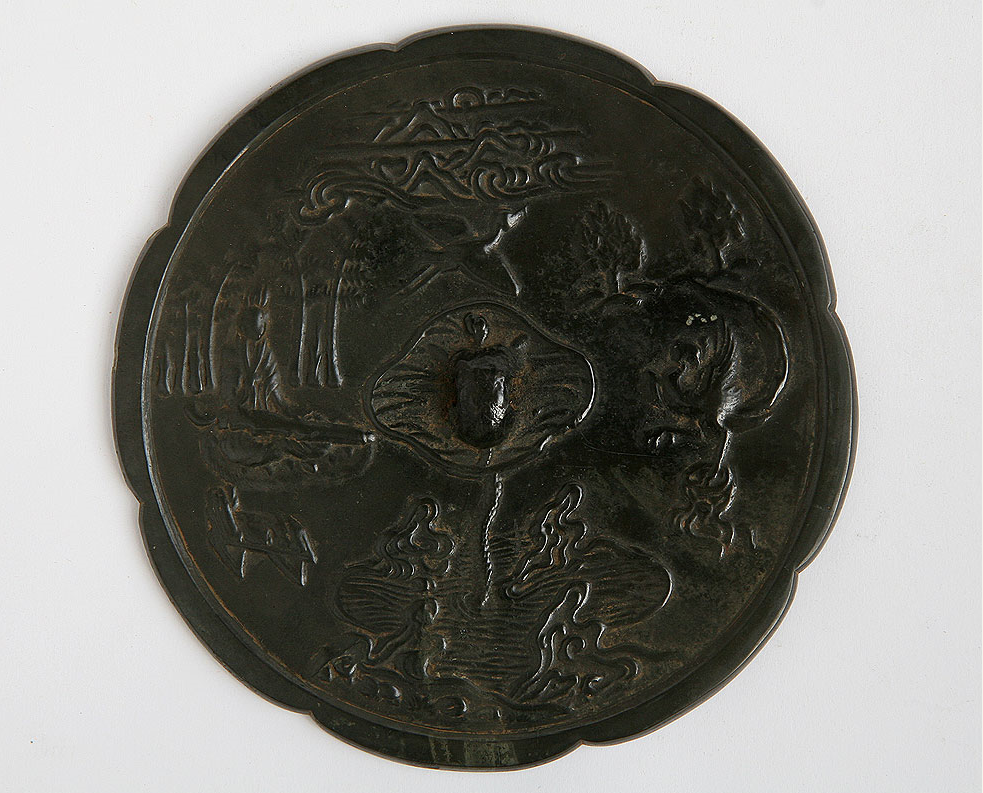
Zhenzi Flying Frost Pattern Bronze Mirror

Tang Zhenzi Flying Frost Pattern Bronze Mirror, 15.6 cm in diameter.
It is in the shape of eight sunflowers, with auspicious clouds supporting the moon on the top of the button and pool water and rocks on the bottom. A lotus leaf grows out of the pool, which is the button seat. On the left, a man with a tall hat and a wide belt sits and plays the zither, with an incense table in front and a bamboo forest behind. This picture is actually a reappearance of the story of Yu Boya playing a piece of high mountains and flowing water to find a soulmate, so it is also called "Boya Playing Zither Mirror". Legend has it that the pre-Qin zither player Boya once played the zither in the wilderness, and the woodcutter Zhong Ziqi could actually understand the artistic conception of "lofty ambitions in the mountains" and "vast ambitions in the flowing water". Boya was surprised and said: "Good, your heart is the same as mine." After Zhong Ziqi died, Boya lost his soulmate, smashed his zither and broke the strings, and never played it for the rest of his life. Later, this song was called "High Mountains and Flowing Water", and later generations also used this word to describe a confidant, a soulmate or a piece of music with elegant charm.

Wang Zhenpeng of the Yuan Dynasty, "Bo Ya Playing the Qin" in the Palace Museum
On the right side of the bronze mirror button, there is a phoenix standing on a rock with one foot, flapping its wings and singing, and there is a pool of water under the button. The image of the solitary phoenix dancing in the water is mentioned in the poem "Broken Mirror" by Li Shangyin, a poet of the Tang Dynasty: "After the pheasant is reflected on the Qintai, it is the time for the solitary phoenix to stop dancing." Two allusions are directly quoted here. One is "Yi Yuan" by Liu Jingshu of the Southern Song Dynasty: "The pheasant loves its feathers and dances when reflected in the water. During the reign of Emperor Wu of Wei, the south presented it... Prince Cangshu ordered a large mirror to be placed in front of it. The pheasant danced without stopping to reflect its own image and died of exhaustion." The second is "Preface to the Luan Bird Poem" by Fan Tai, which says: "The king got a Luan bird and loved it very much. He wanted it to sing but couldn't... His wife said: 'I have heard that birds sing when they see their own kind. Why don't you hang a mirror to reflect it?' The king followed her idea. The Luan saw its own image and cried sadly in the middle of the night, and died in a rage." The pheasant dances when reflected in the water and the Luan bird sings when it sees its shadow, which has touched countless infatuated men and women. These legends are very beautiful and moving, and also very tragic, and have become allusions that many poets often use. Therefore, the image of the solitary Luan reflecting the water and dancing non-stop in the mirror is actually a reproduction of this legend.
Boya played the zither to find a soulmate, and the Luan bird danced non-stop in the water. These long-standing and well-known legends are depicted on bronze mirrors, expressing the theme of seeking a mate and a soulmate. People play the zither, phoenixes dance, ponds, lotus flowers, bamboo forests with bamboo shoots, trees, distant mountains, and auspicious clouds holding up the rising sun. Such a beautiful and prosperous picture, so peaceful and harmonious, is really silent at this time, and the inner glittering is the sincere and beautiful light of humanity.


![8.3"China Shang Dynasty,Bronze wine cup [Fuhao Jue cup][妇好爵杯]](http://bronzc.com/cdn/shop/files/4ee0482982cfa89bb4d1cff3333a55e6_e3ca0b86-22fc-497d-9afd-578c551225a3-2.jpg?v=1733986652&width=533)

![12.8" China Ming Dynasty, Phoenix-patterned bronze vase[Ming Wanli Phoenix-patterned vase][明万历凤纹瓶]](http://bronzc.com/cdn/shop/files/4ee0482982cfa89bb4d1cff3333a55e6_a516991b-2bb9-4b2f-a2b6-4354129d006c.jpg?v=1733986953&width=533)

![14.6" China Eastern Han Dynasty Bronze vessel in the shape of a flying horse,Also known as bronze galloping horse[Horse Stepping on Flying Swallow][马踏飞燕]](http://bronzc.com/cdn/shop/files/4ee0482982cfa89bb4d1cff3333a55e6_aa3fbeb8-e08b-4a44-929a-13411ca8fb17-2.jpg?v=1733987211&width=533)

![5.9"China Tang Dynasty, Bronze of a walking dragon[Tang Walking Dragon][唐走龙]](http://bronzc.com/cdn/shop/files/2_8cb416b9-ebbd-4fe2-a905-b9277f820c16.png?v=1731488701&width=533)
